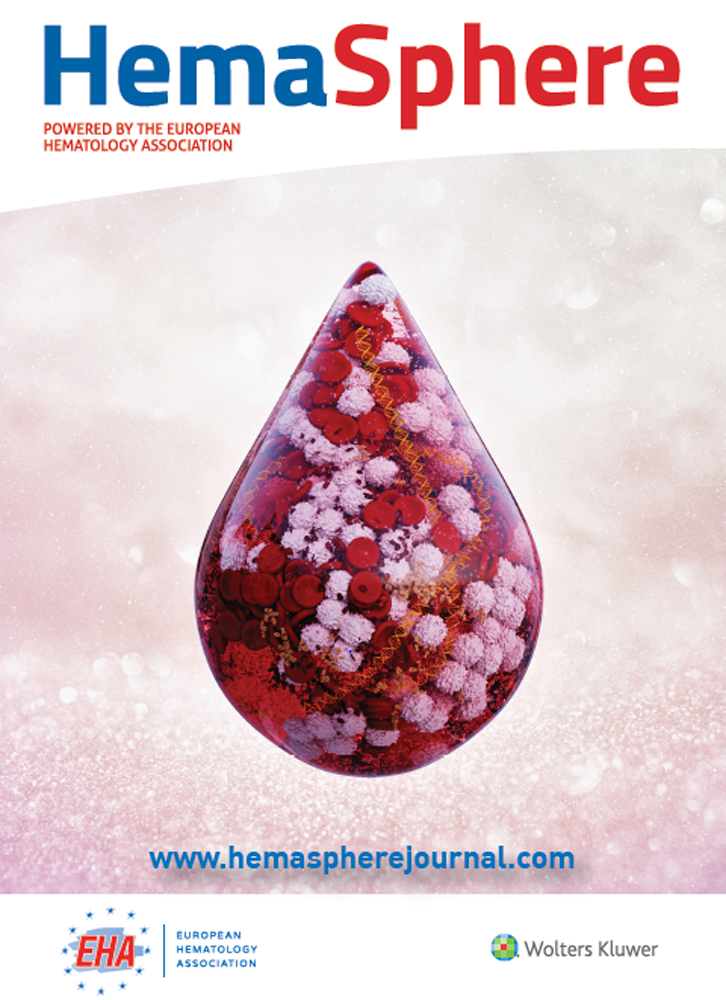Gene Expression of CXCL1 (GRO-α) and EGF by Platelets in Myeloproliferative Neoplasms
Ryan J. Collinson and Allegra Mazza-Parton are equal, first authors.
The authors declare no conflicts of interest.
We read with interest the recent publication by Øbro et al in HemaSphere documenting elevated cytokine levels in patients with myeloproliferative neoplasms (MPN).1 Specifically, their finding of a signature associated with essential thrombocythemia (ET) that included three biomarkers: GRO-α, EGF and eotaxin. GRO-α was of greatest interest as elevated levels were associated with disease transformation to myelofibrosis (MF). Further, based on intracellular flow cytometry, the source of GRO-α was found to be CD56+CD14+ pro-inflammatory monocytes. Since GRO-α is stored within and secreted from platelet granules upon activation, the associated editorial hypothesized whether the circulating GRO-α could be platelet-derived.2 We have explored this possibility, using a targeted next-generation sequencing approach, to assess whether the expression of genes encoding these cytokines is dysregulated in platelets from patients with MPN.3 We also assessed EGF and eotaxin to determine whether the changes seen in circulating levels have any platelet association in MPN subtypes.
Blood was collected from 70 MPN patients (21 PV, 33 ET, 16 MF) and 15 controls, 40 of whom have been previously described.3 The project had ethical approval from the Sir Charles Gairdner Hospital (#2012–094, #2016–107) and University of Western Australia Human Research Ethics Committees (#RA/4/1/6566, #RA/4/1/9100), in accordance with the Declaration of Helsinki. Platelets were isolated, RNA extracted (miRNeasy Mini Kit, Qiagen) and libraries prepared (Ion AmpliSeq Transcriptome Human Gene Expression Kit, ThermoFisher Scientific).3 Equimolar concentrations of barcoded libraries were pooled and underwent automated template preparation and sequenced on an Ion Proton Sequencer (ThermoFisher Scientific) using Ion PI v3 Chips and Ion PI Hi-Q Chef Kits. Processing of barcoded reads, base calling, alignment (human genome build 19), run metrics and gene expression counts were generated using Torrent Suite Software v5.4 (ThermoFisher Scientific). DESeq2 (R/Bioconductor; http://www.bioconductor.org/) was used to normalize counts and perform differential gene expression analysis for CXCL1 (GRO-α), EGF and CCL11 (eotaxin).4 Statistical analysis of normalized counts was performed using one-way ANOVA followed by Tukey's multiple comparisons test using GraphPad Prism version 8.3.1 for Windows, GraphPad Software, San Diego, California, USA, www.graphpad.com.
CXCL1 (GRO-α) transcript levels in ET and PV were comparable and did not differ significantly from controls with 0.614-fold (padj = 0.353) and 0.727-fold (padj = 0.637) changes in expression, respectively. However, in MF there was a 5.81-fold (padj = 5.77 × 10–5), 9.46-fold (padj = 4.11 × 10−10) and 8.00-fold (padj = 2.57 × 10−7) increase in expression compared with control, ET and PV, respectively. EGF transcript levels were highest in ET and PV, with 1.69-fold (padj = 8.65 × 10−5) and 1.52-fold (padj = 9.05 × 10−3) increase in expression compared to controls. In MF, there was a 0.684-fold (padj = 0.012) change in EGF expression compared to controls. These changes in platelet EGF transcript levels mimicked the cytokine levels as reported by Øbro et al, and is in keeping with platelets being the source of circulating EGF.5 Our data reaffirms Øbro et al's observation that decreased levels of EGF is associated with progression to MF.1 The expression levels for CCL11 (eotaxin) in platelets from all MPN subtypes were minimal and did not differ from controls. This is as expected, since eotaxin is mainly produced by structural and infiltrative inflammatory cells.6 Data for all gene transcripts are shown in Figure 1.
Our platelet transcript data show that platelets in MF, but not ET or PV, have statistically significantly elevated CXCL1 (GRO-α) expression. This is of interest as GRO-α is produced by megakaryocytes and platelets in a thrombopoietin-inducible manner.7 Platelets store GRO-α in the α-granules whereupon it is released on platelet activation and granule exocytosis. This induces platelet tethering to CD14+ monocytes via CD62P and P-selectin glycoprotein ligand-1 (PSGL-1) binding. The platelet-monocyte binding is associated with increased monocyte activation and production of pro-inflammatory cytokines IL-6 and TNF-α, as well as transition to an adhesive phenotype, through upregulation of Mac-1 and VLA-4. In MPN, megakaryocyte production and apoptosis, megakaryocyte thrombopoietin signal transduction and platelet function are all abnormal, with the most significant defects being in MF.8-10 Our finding of increased CXCL1 (GRO-α) platelet gene expression in MF, together with the increased GRO-α cytokine production from CD56+CD14+ monocytes in ET by Øbro et al suggests the platelet-monocyte nexus may have an important contribution to the inflammatory cytokine profile of MPN and disease progression.

Transcript levels of CXCL1 (GRO-α), EGF, and CCL11 (eotaxin) in platelets from patients with MPN and controls. Error bars show mean with 95% confidence interval. One-way ANOVA followed by Tukey's multiple comparisons test ∗p < 0.05, ∗∗p < 0.01, ∗∗∗p < 0.001, ∗∗∗∗p < 0.0001.
Both platelets and CD56+CD14+ monocytes may therefore be sources of GRO-α in MPN. While activated pro-inflammatory monocytes were shown to be the source of GRO-α in ET,1 the basis for the decreased GRO-α cytokine levels in MF still requires explanation. If platelets are a major source of GRO-α, as seen in reactive thrombocytosis, then the low cytokine levels in MF may be due to failed production, or loss of GRO-α because of hypoactive and “exhausted” platelets.2 Further transcriptomic, proteomic and functional studies are required to characterize the platelet-monocyte nexus and its potential role in chronic inflammation and disease progression in MPN.
Disclosures
The work was supported by grants from the Raine Medical Research Foundation, the MPN Research Foundation and the Ruby Red Foundation. RJC is supported by the Paul Katris Honours Scholarship from the Cancer Council Western Australia. BBG is supported by the Gunn Family National Career Development Fellowship for Women in Haematology from Snowdome Foundation and Maddie Riewoldt's Vision. MDL is an ISAC Marylou Ingram Scholar.




